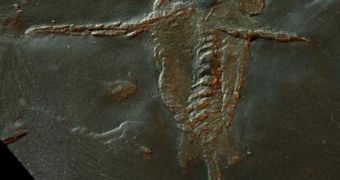A 390 million year-old fossil of a long-extinct animal sheds new light on the evolution of scorpions and horseshoe crabs, and especially on how they developed their frontal claws. The perfectly-preserved specimen is the only one known of its species, and has been named Schinderhannes bartelsi. Investigators from the Yale University and the University of Bonn in Germany have contributed to the research, which has taken place at a spot known as the Hunsrück Slate.
"With a head like the giant Cambrian aquatic predator Anomalocaris and a body like a modern arthropod, the specimen is the only known example of this unusual creature," Derek Briggs, who is the director of the Peabody Museum of Natural History at Yale and also an author of the recent paper detailing the find, published in a recent edition of the journal Science, explains.
"Sadly, the quarry from which this fabulous material comes has closed for economic reasons, so the only additional specimens that are going to appear now are items that are already in collectors' hands and that may not have been fully prepared or realized for what they are," the scientist adds.
The paired grasping appendages, found on the head of scorpions and horseshoe crabs have puzzled researchers for a long time, and now they believe they may have found the missing link connecting modern arthropods to Anomalocaris, their ancient predecessor. However, what still baffles the team is the fact that Schinderhannes lived more than 100 million years after creatures with such head structures were originally thought to have gone extinct.
The new fossil has proved that the size of these animals became smaller over time. While its predecessors reached as much as 3 to 4 feet (roughly 1 meter) in length, the found remains hint to an animal only 4 inches long. The beast used a pair of large triangular wing-like limb for propulsion, not unlike the so-called wings penguins employ nowadays to navigate through water.
The animal featured large bulbous eyes, most likely an adaptation to its environment, a circular "mouth," and a pair of appendages over it that each had spines projecting inwards along their length. It was by no account a beautiful creature, but one that instilled fear in others its size.

 14 DAY TRIAL //
14 DAY TRIAL //